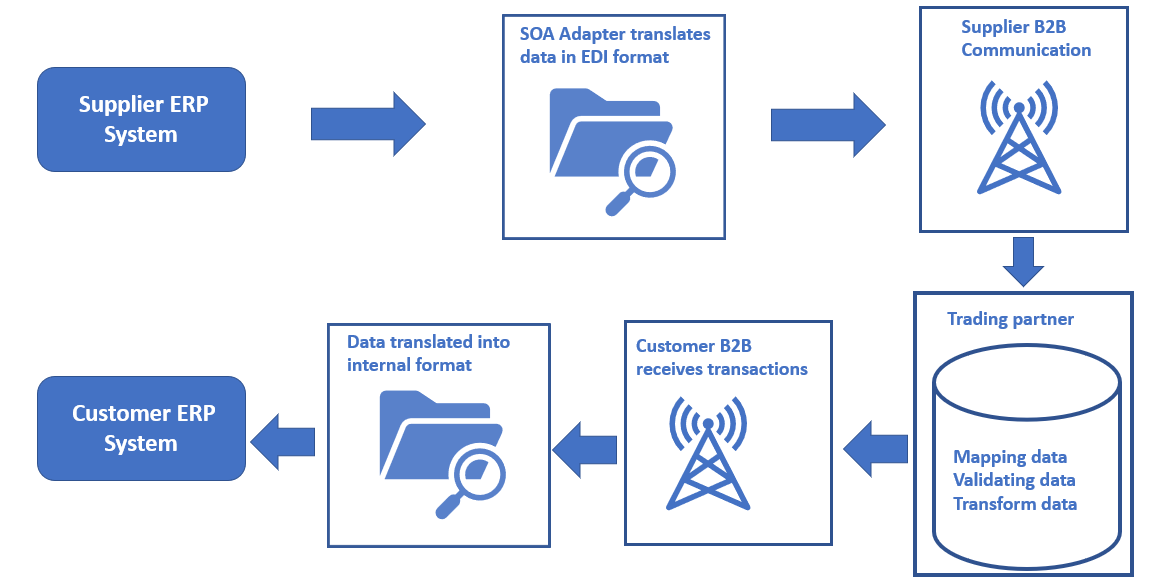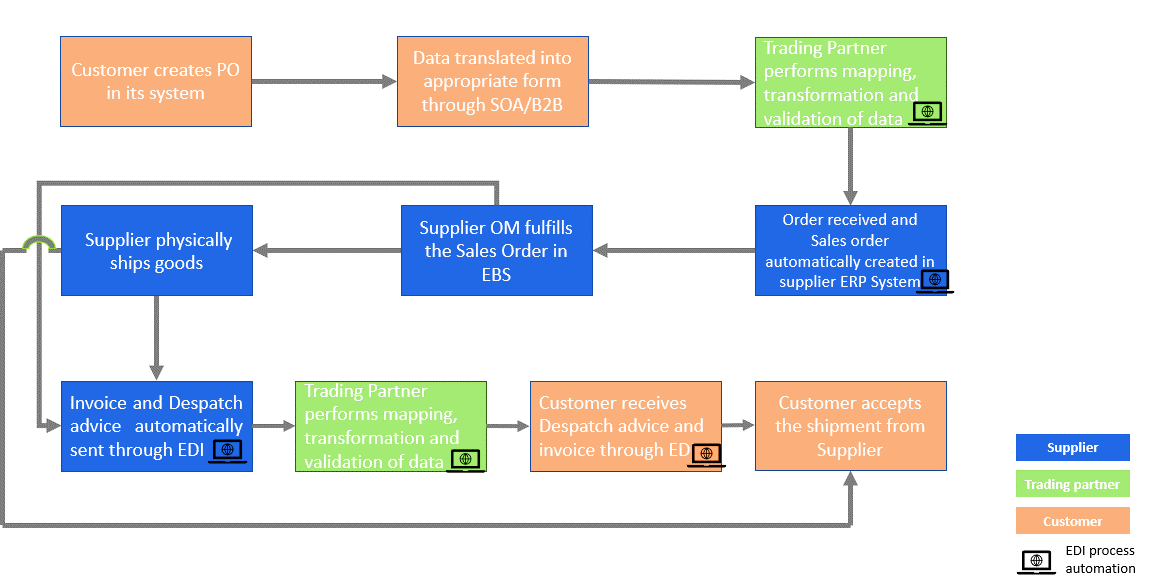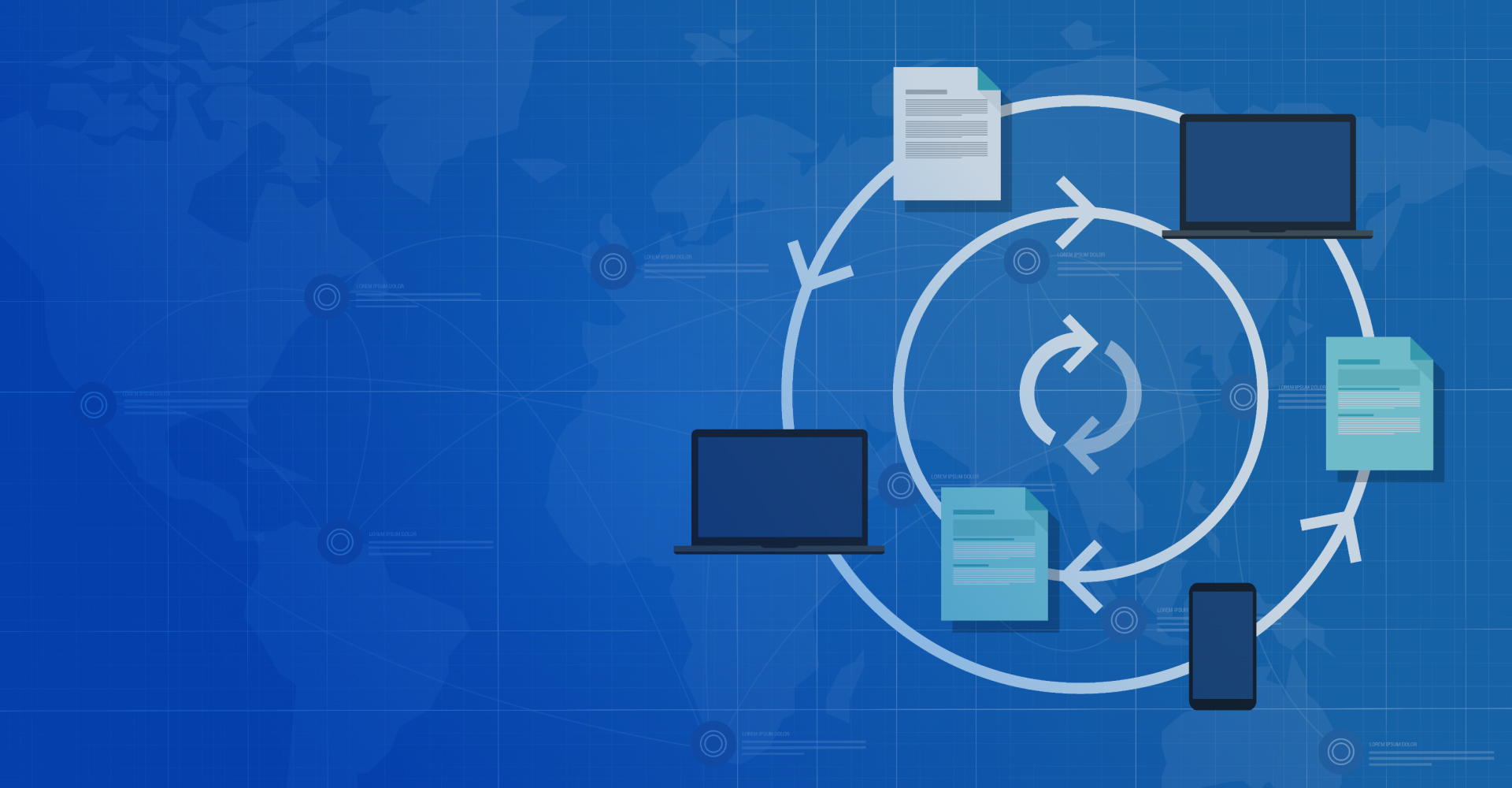Various EDI Integration Standards
There are standard formats of EDI documents, such as EDI 810 (for invoices), EDI 855 (for order responses), EDI 856 (for dispatch advice), and EDI 850 (for orders), which ensures both the supplier and customer abide by the standard format and segments (fields) in the EDI file (also known as edifact file), so they are clearly understood and interpreted by either party. This process also ensures that the documents are automatically generated in the corresponding ERP system when sent or received from a supplier or customer.
For example, if a customer wants to order some items from a supplier, the customer only needs to create a purchase order in its ERP system. The corresponding sales order would automatically create in the supplier’s ERP system, once the EDI document generated through the customer’s SOA/B2B layer interfaces with the supplier’s systems.
This ensures a faster document transmission process and that there is no need for manual entry. Similarly, once the supplier ships the items to the customer, the customer instantly gets informed of the shipment through the EDI 856 document. The customer also knows the date by which the shipment will arrive.
The following are some of the benefits provided by B2B/EDI Integration
- Reduction in human error and enhanced transaction security due to data being validated at various levels (Edifact file, SOA, B2B, Trading partner)
- Increased business efficiency by making sure that statutory and legal compliance are met and validated at all times
- The scalable process to add new customer sites easily and efficiently
- Capability to monitor errors and fix them proactively
- Capability to process orders in bulk
EDI Integration General Process Overview
Typically, an EDI flow includes an SOA layer and a B2B layer. SOA connectors convert incoming data and output data into a standard format. This ensures that the generated EDI file is in a format that the customer or the trading partner can readily accept.
B2B gateways are a communication layer between two trading partners. This is generally a two-way communication layer that uses the EDI messaging format. The other formats usable by the B2B layer are XML and cXML. THE B2B layer contains certain validation points corresponding to the respective organization to make sure that both the incoming and outgoing data adhere to a certain standard, to ensure that the data is secure and any unwanted data segments are rejected or transformed.
Trading partners help transform and map data between the customer and supplier. Since there are certain legislative and statutory requirements of each country and region, the trading partners make sure that the EDI documents abide by those requirements and help send the documents to the central agency of the country/region.
The different types of EDI are EDI through VAN, EDI through AS2, and EDI using FTP/SFTP
AS2 (Applicability Statement 2) is an internet communication protocol that enables data to be transmitted securely over the internet using digital certificates and encryption.
EDI through VAN (Value Added Networks) is a process where there are mailboxes that help to send and receive the EDI messages.

EDI Integration Best Practices
To make sure that the documents are transmitted and received securely and without errors, certain best practices need to be followed.
- Carry out a detailed Gap Analysis to determine the segments (fields) in the edifact file sent/received against the supplier/customer file. For example, if the customer has sent a sample edifact file for invoices (EDI 810) that shows an additional segment denoting the item price with tax, it is important that this segment is included in the edifact file or is mapped correctly with the corresponding segment if this segment value is already available.
- There are cases when the customer may require a certain segment/field for specific scenarios. For example, if items are lot controlled, some customers may not need the lot expiry date, but certain customers may always need the lot expiry date. The customer should request the EDI guide to ensure that such cases are not missed. This guide should detail all the header and line segments that are mandatory or optional.
- If a trading partner is responsible for data translation and mapping, ensure that the edifact file remains the same and that the trading partner should be responsible for the correct mapping for different customers. For example, if Edicom is the trading partner used for the Spain region, ensure that the same EDI 810 (invoices) file is sent to Edicom and Edicom makes any change required for specific customers. Say a customer only wants acceptances and rejections but no changes as part of order responses, the same EDIFACT file should be sent to Edicom, and the trading partner (Edicom) needs to change the mapping on its end.
- A dashboard should show if the EDI document has been sent, delivered, not sent, in process, or rejected status. If possible, the reason for rejection should also be configured through code, which will help identify the reason for rejection, which could be due to a missing segment or an incorrect value of a segment.
- Prepare a detailed requirements document to identify the scenarios that the customer/supplier wants in EDI Integration.
- The GTIN numbers should be mapped appropriately with internal/external item numbers of the supplier/customer.

The above diagram shows an order-to-cash process showing the transmission of EDI documents between the business partners during various steps of order fulfillment and order acceptance.
Conclusion
In conclusion, implementing EDI integration for multiple channel partners can streamline business operations and improve the efficiency of supply chain management. With EDI, businesses can reduce errors and delays in document processing, minimize costs associated with manual data entry, and enhance collaboration with their partners. Moreover, EDI integration can help businesses stay competitive in the digital marketplace by enabling them to deliver goods and services faster, more accurately, and at lower costs. Therefore, businesses that adopt EDI integration can reap numerous benefits, including improved productivity, increased customer satisfaction, and enhanced profitability.













